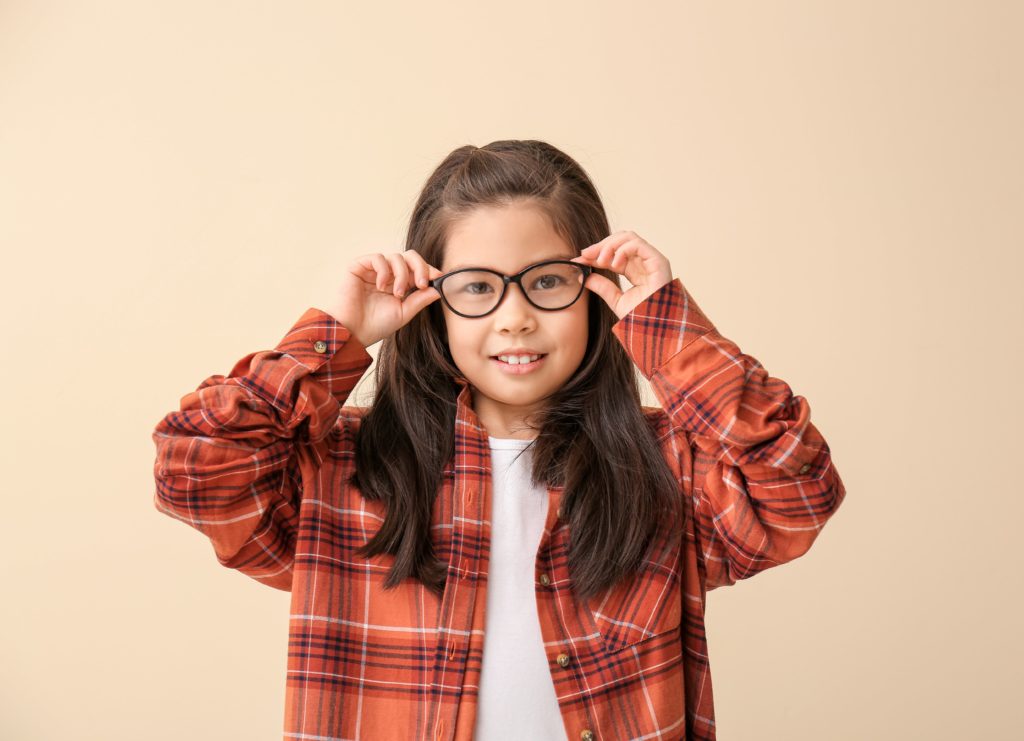If you’ve noticed your child squinting, rubbing their eyes often, complaining about headaches, or having trouble seeing the board at school, there is a possibility they have myopia.
Myopia, also known as nearsightedness, is a common vision problem that usually appears between the ages of 6 and 14. Children who have nearsighted parents are more likely to develop myopia, however, myopia is becoming more common among children.
Myopia causes the eyeball to be slightly longer from front to back than usual. Light rays that form images that we see focus in front of rather than directly on the retina causing distant objects to appear blurry and unclear.
Progressive myopia typically affects children and is a type of myopia that needs an increased prescription to correct year over year.
How to Tell if Your Child Has Myopia
To avoid getting glasses, some kids downplay vision issues. Although a quick eye check is typically part of a back-to-school physical, your child’s eyes might change during the year.
If your child is trying to hide their vision issues, how can you tell when they need help? Some signs of myopia in children include:
- Sitting at the front of the classroom
- Squinting
- Frequent headaches
- Lack of interest in sports that require long-distance vision
- Holding books close to their face
- Moving closer to see the tv
- Rubbing their eyes
Make an appointment with an eye doctor if your child is exhibiting nearsightedness symptoms. Early treatment in children is essential to prevent its effects on academic performance and interference with extracurricular activities.
What Causes Myopia?
Myopia in childhood is most commonly caused by the eyes growing too quickly or continuing to grow when eye growth should normally stop.
This excessive growth can be attributed to genetics, environment, and individual characteristics.
Myopia progresses more quickly in younger children because their eyes grow faster, resulting in higher levels of myopia, stronger glasses, and more eye health risks.
Myopia is caused by a variety of factors that vary from person to person. Both genetic and environmental factors are at work.
Genetics
Myopia is a well-known hereditary condition. A child is more likely to experience myopia if one or both parents have it. Myopia can occur in many children whose parents have perfect vision, so genetics cannot be the only cause.
Ethnicity
Ethnicity contributes to the development of myopia. Children of Middle Eastern, Hispanic, African/Caribbean, and East Asian and South Asian ancestry are most at risk, with Caucasian children at lower risk.
Treatments for Myopia in Children
Factors you can control
There are a few things you can do as a parent to control myopia progression in your child.
Spend More Time Outdoors
It’s common for parents to worry that their kids are spending too much screen time watching TV or on their devices. This is for good reason, the amount of time spent on devices reduces the amount of time your child is playing outdoors.
There is evidence that children who spend limited time outside are more likely to develop myopia. Spending more time outside can also help prevent or delay the onset of myopia.
While the exact reason is unknown, it’s thought to be related to the amount of ambient light received by the eye outdoors versus indoors, and that exposure to large amounts of sunlight helps modulate proper and correct eye growth.
The total amount of outdoor time is more important than the type of outdoor activities involved.
Regular Eye Exams
Myopia can potentially be avoided by having your child undergo routine eye exams beginning at a young age.
Regular eye exams are even more crucial if there are known myopia risk factors, like family history, as children’s eyes can change quickly and frequently without them complaining. Delays in myopia diagnosis and treatment will accelerate its progression.
Can I Slow the Progression of My Child’s Myopia?
Orthokeratology
To slow the progression of myopia, your eye doctor might suggest Orthokeratology. Orthokeratology is the use of a contact lens at night to correct blurry distance vision during the day. The lenses, also known as Ortho-K lenses, flatten your cornea while you sleep. The light that passes through the reshaped cornea falls precisely on the retina the next day, making distant images appear clearer.
Wearing Ortho-K lenses improves vision only temporarily. When you stop wearing the lenses, the cornea gradually returns to its original shape, and myopia returns. Nonetheless, ortho-K may provide some long-term reduction in myopia progression.
Atropine
During an eye exam, atropine eye drops are used to dilate your pupils. The drops may slow the progression of myopia when given to kids over two to three years in small doses.
Although doctors are unsure of how exactly it works, they believe that these drops may prevent the eye from lengthening.
What’s The Next Step?
If you’re concerned your child may be experiencing myopia, you should consider a full eye examination as soon as possible.
Early detection is key to ensuring your child’s wellbeing and success in their school and recreational activities. Book your child’s eye exam with 2020 Eyecare Ohio today.



